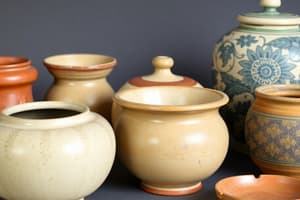Podcast
Questions and Answers
What is the definition of clay?
What is the definition of clay?
- A decomposed granite-type rock of fine particle size (correct)
- A type of plastic
- A colorant used in pottery
- A high-temperature clay body
What material does the term 'ceramics' originally refer to?
What material does the term 'ceramics' originally refer to?
- A water-based slip
- A glazing technique
- A type of clay body
- Any material prepared with the use of fire (correct)
What does plasticity refer to in pottery?
What does plasticity refer to in pottery?
The ability of clay to stretch without cracking and hold a shape.
What is a clay body?
What is a clay body?
What temperature range is considered low for earthenware?
What temperature range is considered low for earthenware?
What distinguishes stoneware from other clay types?
What distinguishes stoneware from other clay types?
What is porcelain?
What is porcelain?
What does 'leather hard' mean in pottery?
What does 'leather hard' mean in pottery?
What is greenware?
What is greenware?
What is bisqueware?
What is bisqueware?
What is the purpose of firing in pottery?
What is the purpose of firing in pottery?
What type of oven is used to fire clay?
What type of oven is used to fire clay?
What is wedging in pottery?
What is wedging in pottery?
What does throwing refer to in pottery?
What does throwing refer to in pottery?
What is slip in pottery?
What is slip in pottery?
What does scoring mean in pottery?
What does scoring mean in pottery?
What is sgraffito?
What is sgraffito?
What is glaze in pottery?
What is glaze in pottery?
What is an oxide in pottery?
What is an oxide in pottery?
What is majolica?
What is majolica?
What is engobe?
What is engobe?
What is underglaze?
What is underglaze?
Flashcards
Clay
Clay
A decomposed granite-type rock, consisting of fine particles.
Ceramics
Ceramics
Materials prepared using fire, initially including glass.
Plasticity
Plasticity
The ability of clay to stretch without cracking and maintain its shape when formed.
Leather hard
Leather hard
Signup and view all the flashcards
Clay body
Clay body
Signup and view all the flashcards
Earthenware
Earthenware
Signup and view all the flashcards
Stoneware
Stoneware
Signup and view all the flashcards
Porcelain
Porcelain
Signup and view all the flashcards
Greenware
Greenware
Signup and view all the flashcards
Bisqueware
Bisqueware
Signup and view all the flashcards
Firing
Firing
Signup and view all the flashcards
Kiln
Kiln
Signup and view all the flashcards
Wedging
Wedging
Signup and view all the flashcards
Throwing
Throwing
Signup and view all the flashcards
Slip
Slip
Signup and view all the flashcards
Scoring
Scoring
Signup and view all the flashcards
Sgraffito
Sgraffito
Signup and view all the flashcards
Glaze
Glaze
Signup and view all the flashcards
Oxide
Oxide
Signup and view all the flashcards
Majolica
Majolica
Signup and view all the flashcards
Engobe
Engobe
Signup and view all the flashcards
Underglaze
Underglaze
Signup and view all the flashcards
Study Notes
Clay and Ceramics
- Clay is a decomposed granite-type rock, consisting of fine particles.
- Ceramics, derived from the Greek word "Keramos," refers to materials prepared using fire; initially included glass.
Properties of Clay
- Plasticity is the ability of clay to stretch without cracking and maintain its shape when formed.
- Leather hard indicates a state where clay is stiff but not completely dry, showing no visible color change.
Types of Clay Bodies
- Clay body is a mixture of various clays designed for workability.
- Earthenware is a low-temperature clay (1800-2000°F) that is porous post-firing, suitable for planters and dinnerware.
- Stoneware is a high-temperature clay (2300°F+) that is dense, hard, and available in various colors (white, brown, buff).
- Porcelain is a very high-temperature clay made only from white clays, used for fine china and sculpture, noted for its density and hardness.
Clay Stages
- Greenware refers to clay items that are dry yet unfired, while bisqueware includes pieces that have undergone initial firing and are ready for glazing.
Firing and Equipment
- Firing is the heating process that hardens clay and melts glaze.
- A kiln is a specialized oven for firing clay, which can be electric, gas, or wood-burning. Electric kilns are commonly used in studio settings.
Techniques in Pottery
- Wedging involves kneading clay to remove air bubbles and create an even texture.
- Throwing is the technique of shaping clay on a potter's wheel.
- Slip is a clay-water mixture with a paint-like consistency, used for attaching clay pieces.
- Scoring involves roughing edges of clay pieces that need to be bonded.
Decorative Techniques
- Sgraffito, or incising, includes carving designs into leather-hard clay.
- Glaze provides a thin, glass-like coating for water-proofing and decorating surfaces.
- Oxide is a colorant for adding hues to glazes and slips, often combined with a white majolica glaze.
- Majolica features earthenware with a thick white glaze and decorative oxide elements.
- Engobe is a special slip designed for decorating damp greenware.
- Underglaze is a colored slip applied under a clear glaze on bisqueware for decoration.
Studying That Suits You
Use AI to generate personalized quizzes and flashcards to suit your learning preferences.



